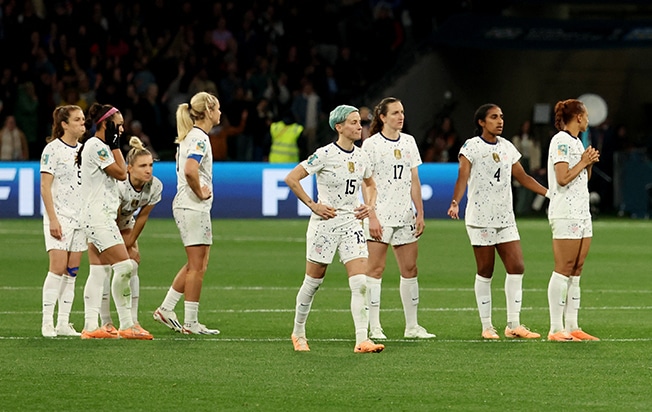The United States came to the Women’s World Cup bullish about their chances of winning an unprecedented third consecutive title but their round-of-16 exit at the hands of Sweden showed their campaign was built more on hope than substance.
After back-to-back World Cup triumphs under Jill Ellis in 2015-19, Vlatko Andonovski’s efforts to regenerate the four-time champions will be judged a failure in the wake of their 5-4 loss on penalties in Melbourne on Sunday.
The U.S. suffered their earliest elimination at the World Cup by far, having never failed to reach the semi-finals in all eight previous tournaments.
Megan Rapinoe’s brilliant international career ends on a sour note and the Sweden loss will sting for other team mates of a golden generation unlikely to hang on for the next World Cup in another four years.
The 2019 World Cup in France will now be seen as the high-water mark for a once peerless team that seemed bigger than the game itself for much of the decade.
The game has changed irrevocably since the U.S. beat the Netherlands 2-0 in the Lyon final in France, with increased investment in women’s soccer paying dividends in Europe.
The U.S.-based National Women’s Soccer League (NWSL) is no longer the most attractive destination for the world’s top talent.
Many players now aspire to lucrative contracts with storied European clubs and the dream of a Champions League trophy in front of enormous crowds.
Loyal U.S. women have been left in a weakening domestic field and further dilution can be expected with plans for new teams in coming years.
Those concerns were buried under a hyperbolic narrative about the supremacy of American women’s football, a myth that endured right up to the tournament in Australia and New Zealand.
“We don’t just play the world’s game. We run it,” twice World Cup winner Brandi Chastain said in a pre-World Cup promotion for the NWSL.
For all the bluster, the cracks have been in plain sight for years.
Under Andonovski, the U.S. went out of the semi-finals at the Tokyo Olympics and had to rely on veterans Rapinoe and Carli Lloyd to win them a bronze medal.
They built a long winning streak last year against a succession of modest opponents but were exposed by European champions England, with further losses to Spain and Germany to follow.
Victory at the SheBelieves Cup early this year proved a chimera rather than evidence of a team back to their best.
Injuries undoubtedly made their World Cup mission tougher, with captain Becky Sauerbrunn and forward Mallory Swanson ruled out of the squad.
Yet, the U.S. never looked like World Cup winners when the tournament kicked off.
Held 1-1 by the Netherlands, they would have been eliminated by debutantes Portugal in the group phase if the post had not saved them in the scoreless draw.
The sight of Rapinoe and other players dancing and smiling on the pitch after the Portugal escape enraged the now-retired Lloyd, who suggested the team were suffering from denial in her work as a television analyst.
It was hard to think otherwise when Rapinoe said she had “blind confidence” in herself and her team mates, and that the U.S. could only improve.
On Sunday, Rapinoe blazed her spot kick over the bar, one of three Americans to miss in the shootout.
The World Cup exit leaves U.S. women’s soccer at a cross-roads, and pondering a way out of the mire.

